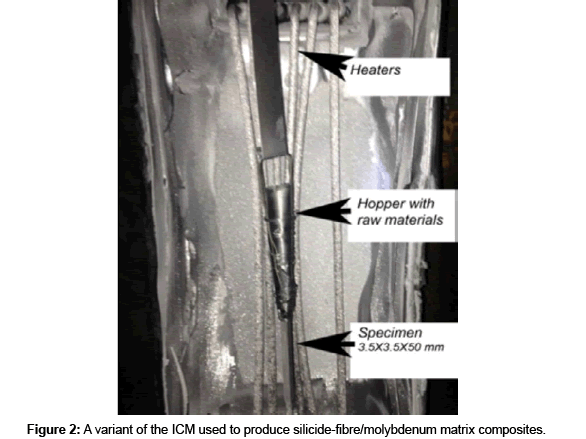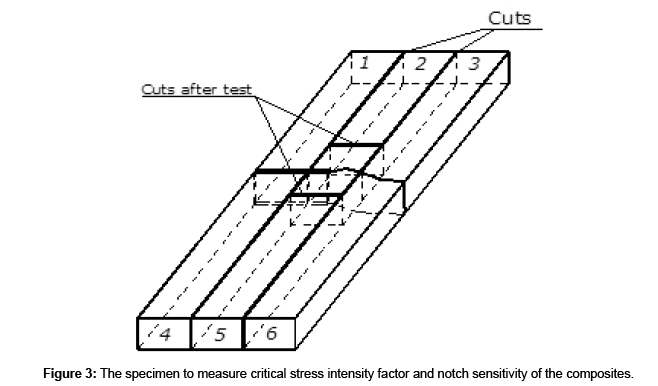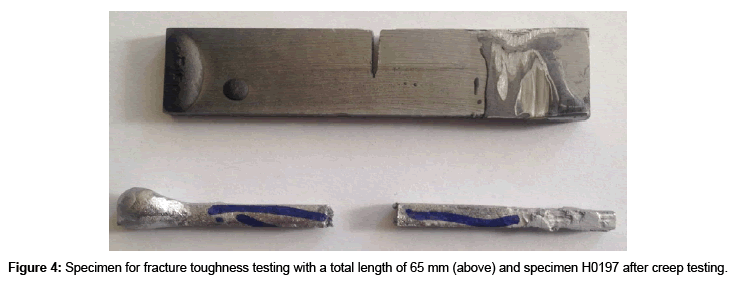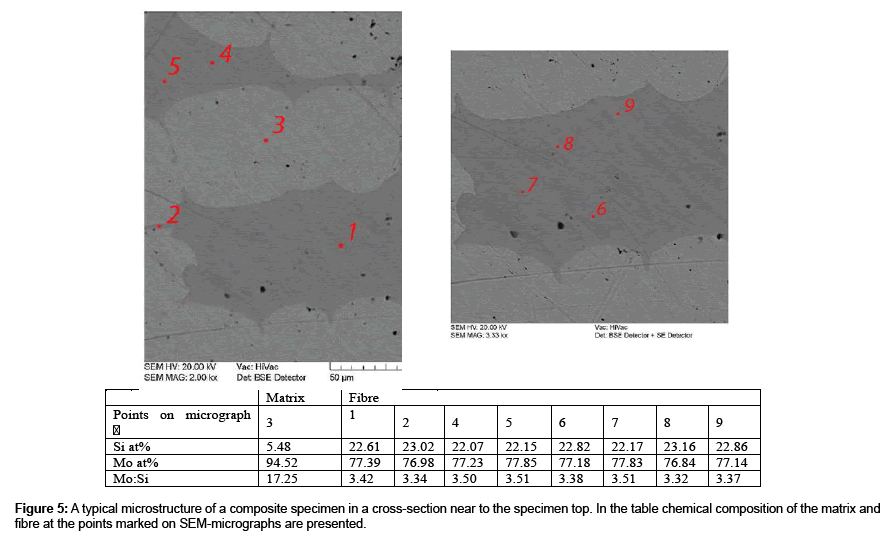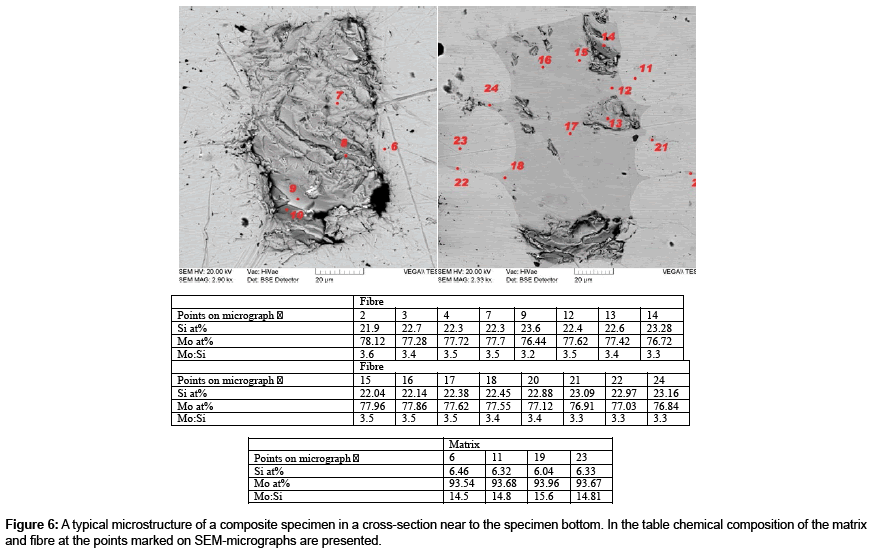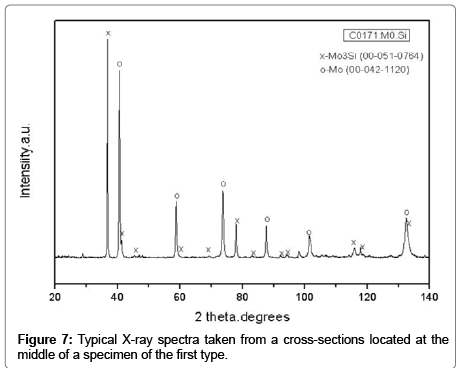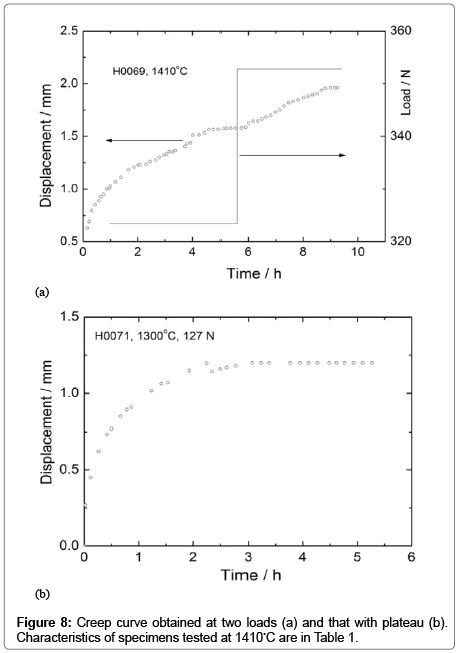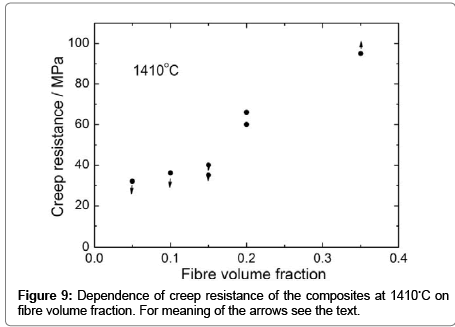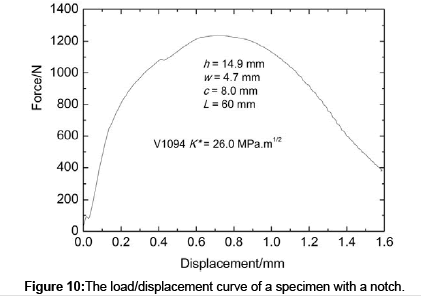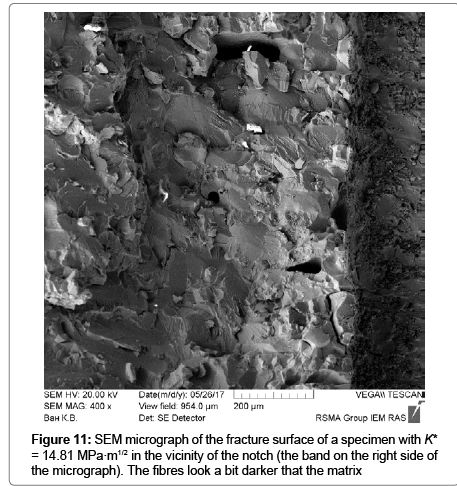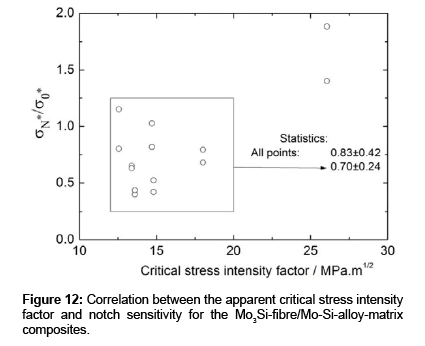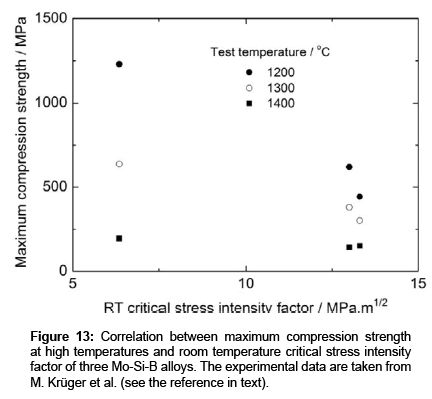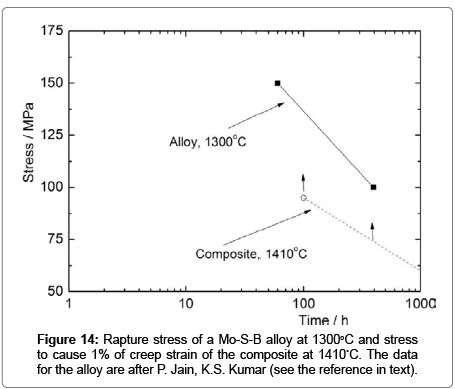Research Article, Res Rep Metals Vol: 1 Issue: 2
Silicide-Molybdenum Fibrous Composites: Fracture Toughness and Creep Resistance
Mileiko ST1*, Chumichev VA1, Novokhatskaya NI1, Shakhlevich OF1, Stolin AM2, Bazhin PM2 and Prokopenko VM1
1Institute of Solid State Physics of RAS, Chernogolovka Moscow distr., Russia
2Institute of Structural Macrokinetics and Materials Science of RAS, Chernogolovka Moscow distr, Russia
*Corresponding Author : Mileiko ST
Institute of Solid State Physics of RAS, Chernogolovka Moscow distr., Russia
Tel: +7 (49652) 22493
E-mail: mileiko@issp.ac.ru
Received: April 10, 2017 Accepted: May 27, 2017 Published: May 31, 2017
Citation: Mileiko ST, Chumichev VA, Novokhatskaya NI, Shakhlevich OF, Stolin AM,et al. (2017) Silicide-Molybdenum Fibrous Composites: Fracture Toughness and Creep Resistance. Res Rep Metals 1:2.
Abstract
There is shown a possibility to use the internal crystallisation method, which was developed earlier as a base for crystallisation of oxide fibres in a molybdenum matrix, to produce silicide/molybdenum fibrous composites. A series of the experiments resulted in obtaining composites with Mo3Si-based fibres and molybdenum alloy matrix. Composite specimens obtained have microstructures typical for fibrous composites with a strong fibre/matrix interface bonding. Some peculiarities are arisen as a result of the particular fibre/matrix system under consideration. The composites are characterised by high creep resistance at temperatures up to 1400°C and sufficiently high fracture toughness at room temperature. The results obtained show ways of designing new metal matrix composites for very high temperature use.
Keywords: Composites; Internal crystallization method; Silicide fibers; Refractory metals; Molybdenum; Creep; Fracture toughness
Introduction
Research in the field of high temperature materials for aerospace and energy applications is now going on along the following main directions:
• Improvement of nickel superalloys.
• Development of refractory metal alloys.
• Development of high temperature ceramic matrix composites (CMCs).
• Development of high temperature metal matrix composites (MMCs).
The use temperature of nickel superalloys in heavily loaded structural elements such as turbine blades is limited by a temperature of about 1100°C due to a low melting point of nickel. Therefore, they are not to be considered as future high temperature materials.
The second direction of the research named as “Beyond nickel superalloys” has brought a number of interesting and useful results, first of all due to finding ways to decrease oxidation resistance of niobium- and molybdenum-based alloys [1-5]. Perhaps, the main problem in developing metal alloys including those based on refractory metals is to organize such microstructure of the alloy as to reach a necessary balance between strength (creep resistance) and fracture toughness [1]. Introducing silicide particles into molybdenum matrix yields an increase in alloy strength and creep resistance [2], but at the same time, leads to a decrease in fracture toughness [3,4].
Parallel to the research in this direction there are studies of molybdenum silicides. In the context of the present paper, it should be noted, that various molybdenum silicide crystals are characterised by high mechanical properties [5-7]. The third direction started some decades ago [5,6] has leaded to the development of practically important SiC/SiC and oxide/oxide composites with polycrystalline fibres [7]. The main advantage of the first composite group is, certainly, their high thermal conductivity; for the second group high oxidation resistance should be pointed out as highly positive property. These factors determine the usage of CMC’s in gas turbine technology.
The main advantage of metal matrix composites (MMCs) is their strength/fracture-toughness characteristics. If such composites are designed appropriately their strength and fracture toughness can go up simultaneously with increasing fibre volume fraction [6,8] despite high temperature fibres are normally brittle at room temperature. This is a result of an enlargement of the fracture zone at the crack tip aroused due to multiply fracturing of brittle fibres away from the surface of macrocrack propagation.
A possible fabrication technology for high temperature composites is the internal crystallisation method (ICM) developed some decades ago [6,9] to produce either model composites with molybdenum matrix [17] or oxide fibres [10] to reinforce metal [11- 13] intermetallic [11], and ceramic [12] matrices. Recently it was shown that the method can be used to obtain molybdenum matrix composites of practical importance. This is a result of finding a way to reduce essentially oxidation rate of the molybdenum matrix by reinforcing it with fibres containing oxides of special chemical compositions [12,13].
In the present paper, fabrication technology, microstructure, creep resistance, and fracture toughness of a new family of the molybdenum matrix composites reinforced with silicide fibre, which are produced by using ICM, are briefly described.
Methodology
Producing composite specimens, methods of testing and interpretation of experimental results are described in this section.
Internal crystallizations method
A schematic of the traditional internal crystallisation method to produce oxide-fibre/molybdenum-matrix composites is presented in Figure 1. First, a molybdenum carcass with continuous channels in it is prepared by diffusion bonding of an assemblage of the wire and foil. Then the carcass is infiltrated with an oxide melt (steps 2 and 3) by the capillary force. The melt is crystallised in the channels to form fibres in an oxide/molybdenum block by pulling up the block into a cold zone of the futnace (step 4).
Since molybdenum crucible used in this scheme cannot be used for melting molybdenum silicides and keeping the melt for an indefinite time, the main scheme was changed. Now a disposable hopper containig a charge of the raw material is placed at the top of molybdenum carcass (Figure 2). As soon as the charge melts it goes down infiltrating the channels and interacting with molybdenum of the carcass. Then the whole set is pulled up to the cold zone of the furnace with a rate of 1000 mm/min. Two types of the specimens of a length of about 65 mm were prepared. One type with a crosssectional size of about 3.5×3.5 mm was used for measuring creep resistance; the second type had the cross-sectional size of about 15×5 mm. Specimens of the second type (Figure 3) was used to measure fracture toughness and notch sensitivity of the composites. The notch was made by a diamond tool, radius of the notch tip is 0.15 mm. Two real specimens are presented in Figure 4.
Preparation of raw material
A special feature of the preparation of the raw material, which is either molybdenum disilicide MoSi2 in the specimens of the first type or a mixture of silicides MoSi2 (~ 65%) Mo5Si3 (~26%), Mo3Si (~4%) and Mo in the specimens of the second type, was the usage of Self-Propagating High-Temperature (SHS) synthesis. A reaction in this process is localised in a thin zone that are moving along the raw billet after a short-time initiation. The basic method described [14] was complemented with plastic shearing a material at the synthesis zone, a procedure is possible in a definite temperature interval. Plastic deformation of the material at the SHS process yields a more complete formation of new phases.
Creep tests and evaluating creep characteristics
Creep characteristics of the composites were studied by simplified methods. Simplifications are justified by the initial stage of the composite development. Creep test procedure and a method of the interpretation of test results are described in details [15]. Here we just to point out that the simplicity is determined by testing specimens in 3-point bending at a step-wise changing load and using a solution of creep problem for a rod under bending [16] to find tensile creep characteristics of a composite specimen. Note that testing the specimen under a series of the load gives immediate the value of exponent n in a power approximation of creep-rate/stress dependence.
The second method of evaluation of creep characteristics of the composites developed [17] is based on calculation of the value of n by using creep characteristics of the matrix and strength characteristics of the fibre. This method cannot be fully applied to the composites under consideration; however, a dependence of n on fibre volume fraction of a composite presented [18-29] will be used here to obtain a quantitative correction of the creep data obtained in the present experiments.
Fracture toughness and notch sensitivity
In the present paper, a composite specimen of the second type with a notch, Figure 3, is considered, to a first approximation, as a “black box” without the microstructure. Testing the specimen according to ASTM 399 Standard developed for testing metal alloys yields apparent critical stress intensity factor K* and strength σN* of the notched specimen calculated assuming no stress concentration. We call K* the apparent critical stress intensity factor since the fracture zone at the crack tip in a composite is not localised unlike the context in metal alloys. Testing sub-specimens of the same material obtained by cutting the specimen as shown in Figure 3 gives strength σo* of unnotched specimens and, consequently, ratio σN*/σo* that is notch sensitivity of the composite under consideration.
Results and Discussion
Microstructure
A degree of the interaction of the melt initially being either MoSi2 (melting point is 2020°C) or a mixture of silicides with molybdenum of the hopper and carcass depends obviously on temperature and time of the melt/molybdenum contact. Technological parameters that give a composite microstructure with a distinct fibre/matrix interface shown above have been found empirically. Typical microstructures of a specimen in two cross-sections located at 15 mm
from the top and bottom of it are presented in Figures 5 and 6. SEM-micrographs are completed with the tables giving results of X-ray microanalysis at a number of the points in the cross-sections. These data allow formulating the following conclusions:
An intensive interaction between the MoSi2 melt and molybdenum matrix takes place during the infiltration of the channels in the matrix with the melt. The interaction is going on most intensively along the grain boundaries in the polycrystalline matrix. This leads to a special shape of the fibre/matrix interface. Still, the interface is clearly defined.
The fibre microstructure looks stripy; one stripe contains mainly Mo3Si, the neighbor containing the same enriched with molybdenum.
The matrix contains silicon, the silicon content is close to that typical for modern alloys in the Mo-Si-B system [1-3].
X-ray analysis was performed on a polished cross-section of a composite specimen by using diffractometer Siemens D-500. The phases were identified according to international database JCPDSICDD. They occur to be Mo (00-042- 1120) and Ãœþ3Si (00-051-0764) in Figure 7, which correlates to the results of X-ray microanalysis Figures 5 and 6.
Creep resistance
As mentioned above, this study is a starting stage of the development of silicide/molybdenum fibrous composites. Hence, most of the creep experiments were performed in a simplest way at temperatures 1300 and 1410°C. Typical creep curves in 3-point bending tests are shown in Figure 8. The curve of a type presented in Figure 8a allows estimating the value of exponent n in the creep power law. It occurs to be ~5. In some experiments a creep curves with a plateau like that shown in Figure 8b are observed. In this case the fibres are deforming elastically without breakage, the matrix stress is relaxing [18].
Specimen sizes and values of steady state displacement rates are show in Table 1. These data are used to interpret creep behaviour of the composites, which is done according to the methodology outlined above, in Section 2. Calculating the value of creep resistance (stress to cause 1% creep strain for 100 h) at 1410°C was done assuming n=5. Calculating creep resistance of the composites gives the values given in Table 2. Dependence of the creep resistance of the composites on fibre volume fraction is presented in Figure 9.
| Specimen number | Specimen sizes | Load | Displacement rate | ||
|---|---|---|---|---|---|
| Hight | Width | Distance between supports | |||
| mm | mm | mm | kgf | mm/h | |
| H0067 | 3.5 | 3.5 | 46 | 15 | 12.3 |
| H0068 | 3.5 | 3.5 | 46 | 15 | 0.089 |
| H0069 | 5.25 | 5.45 | 51 | 36 | 0.108 |
| H0069 | 5.25 | 5.45 | 51 | 33 | 0.070 |
| H0070 | 3.6 | 3.55 | 46 | 15 | 0.443 |
| H0073 | 3.6 | 3.55 | 35 | 13 | 0.313 |
| H0197 | 3.4 | 3.36 | 36 | 10 | 0.033 |
| H0198 | 3.4 | 3.25 | 47 | 10 | 0.033 |
| H0202 | 3.4 | 3.15 | 36 | 10 | 0.888 |
| H0206 | 4 | 4.04 | 47 | 8 | 0.171 |
Table 1: Characteristics of the specimen undergone creep test at 1410°C.
IIt is imported to note that n ≈ 5 was determined experimentally for the composite specimen with fibre volume fraction Vf ≈ 0.2. The value of n is increasing with increasing Vf nearly linearly [29], which means that the creep resistance values at Vf < 0.2 is actually smaller than those calculated assuming n = 5, and the values at Vf > 0.2 are larger than calculated ones given in Table 2. The arrows in Figure 9 show quantitative corrections of the calculated values. The corrections bring the dependence of composite creep resistance on fibre volume fraction to linear one up to large values of Vf, which is characteristic for composites with strong fibre/ matrix interface [19]. The composites under consideration are obviously of such a type.
| Specimen number | Fibre volume fraction | n | MPa |
|---|---|---|---|
| Ãœßð | |||
| H0068 | 0.35 | 5 | 95 |
| H0067 | 0.15 | 5 | 35 |
| H0069 | 0.2 | 4.94 | 66 |
| H0070 | 0.1 | 5 | 36 |
| H0073 | 0.15 | 5 | 40 |
| H0198 | 03 | 5 | 91 |
| H0197 | 0.2 | 5 | 60 |
| ÃÂ 0206 | 0.05 | 6 | 32 |
Table 2: Calculated values of creep resistance of the specimen at 1410°C.
Fracture toughness and notch sensitivity
A typical load/displacement curve obtained in testing a specimen of a type shown in Figure 3 to measure critical stress intensity factor is presented in Figure 10. The composite specimen does clearly demonstrate a quazi-plastic behaviour. SEM micrograph of the fracture surface of a specimen with K*=14.81 MPa∙m1/2 in the vicinity of the notch is shown in Figure 11, which reveals a relief characteristic for a composite with a moderate fracture toughness.
The apparent values of critical stress intensity factor K* are presented in Figure 12 together with notch sensitivity σN*/σo*. The data of K \are characterized by a large scatter, K*=16.2 ± 4.7 MPa∙m1/2. Still, the whole interval of the present data is beyond the interval of K* for Mo-Si-B alloys [8,19]. The notch sensitivity are, perhaps, more informative when comparing brittleness or quasi-plasticity of various composites [16] because of the reasons formulated above. This parameter cannot be used to calculate a limiting load on a structural element containing crack-like defects, but the same is true with regard to K* since linear fracture mechanics and characteristic parameters involved in it can hardly be applicable to sufficiently tough composites. The correlation between K* and σN*/σo* exists [16], and further evidence for that can be seen in Figure 12. There should be made three remarks about the data presented in Figure 12. First, one specimen shows very large value of K*, larger than MPa∙m1/2. At the present time, reasons for that are not clear, and more systematic studies are necessary (i) to find the reasons, (ii) to understand how to adjust the microstructure of composites to enhance fracture toughness even more. Secondly, if to evaluate statistical data for notch sensitivity without taking into account the largest values of σN*/σo* then we get σN*/σo* =0.70 ± 0.24. Taking into account all the experimental points yields σN*/σo* =0.83 ± 0.42. Anyway, the notch sensitivity of the composite looks good. Thirdly, the value of σN*/σo* >1 for metal matrix composites are not unusual. This can be explained by special fracture mechanisms in front of macro crack [16].
Fibrous composites versus alloys
It is interesting to compare mechanical behaviour of molybdenumbased fibrous composites and molybdenum alloys hardened by particles. In both cases silicides are used as reinforcing/hardening materials. The comparison cannot be complete as the alloys have been developing for decades; as for the composites their history is just beginning. Still, we do some comparison of a preliminary nature.
As mentioned above, increasing alloys strength by limiting dislocation movements accompanies by decreasing alloy fracture toughness [30]. This is also true for molybdenum alloys filled with silicide particles. A plot of maximum compression strength σ* at high temperatures versus room temperature critical stress intensity factor KIc for a number of such alloys of various chemical compositions made by using data published by Krueger et al. [31], Figure 13, illustrates the σ*/ KIc correlation for the alloys. Note that with the test temperature increasing the correlation is going weaker. That is because a decreasing role of the hardening particles in strengthening the alloys.
Comparison of creep behaviour of the composite at a temperature of 1410°C (Figure 9) with that of a most creep resistant at 1300°C Mo- Si-B alloy in the tests performed by Jain and Kumar [7] is presented in Figure 13. One can see that an extrapolation of the experimental data to 1000 h (for the composite it is done based on the creep model [19]) shows nearly equal values of the creep resistance of two materials. Hence, there should be expected a difference of about 100°C in the use temperature of two materials (Figure 14).
Conclusions
The experimental results presented above allow concluding that
• The internal crystallisation method (ICM) being used normally to crystallise oxide fibres in molybdenum matrix can now be used for more purposes. In particular, crystallising molybdenum silicides has been successfully performed.
• Mo3Si-fibre/Mo-matrix composites produced by ICM are characterised by strong fibre/matrix bonding, which determines high creep resistance of the composites at temperatures up to 1400°C.
• Unlike molybdenum alloys hardened by silicide particles the Mo3Si -fibre/Mo-matrix composites have sufficiently high values of the critical stress intensity factor, their notch sensitivity can be low.
• Obviously, a further research is necessary to optimize technological parameters to stabilize an optimum microstructure of the composites. Also coatings are to be developed to protect the composites from oxidation. This will lead to the formation of a new family of effective heat resistant materials.
Acknowledgements
The results reported have been obtained under financial support of Russian Foundation for Basic Research (Project 14-08-0125) and partly under support of Russian Science Foundation (Project 16-19-10624). The authors also thankful to their colleagues Mrs. N.A. Prokopenko, Mr. A.A. Kolchin and Mr. A.Ya. Mizkevich for valuable assistance in the experimental work.
References
- Das J, Roy B, Mitra R (2012) Mechanism of oxidation in Mo-Si-B based alloy. International Corrosion Conference, India.
- Majumdar S, Schliephake D, Gorr B, Christ HJ, Heilmaier M (2013) Effect of yttrium alloying on intermediate to high-temperature oxidation behavior of Mo-Si-B alloys. Metall Mater Trans 44A: 2243-2257.
- Schliephake D, Azim M, Von Klinski-Wetzel K, Gorr B, Christ H-JR, et al. (2014) High-temperature creep and oxidation behavior of Mo-Si-B alloys with high Ti contents. Metall Mater Trans 45A: 1102-1111
- Cheng J, Yi S, Park J (2012) Oxidation behaviors of Nb-Si-B ternary alloys at 1100oC under ambient atmosphere. Intermetallics 23: 12-19.
- Portillo BI, Varma SK (2010) Oxidation behavior of Nb–20Mo–15Si–5B–20Ti alloy in air from 700 to 1300 ◦C. J Alloy Compd 497: 68-73.
- Mileiko ST (1997) Metal and ceramic based composites. Elsevier, Amsterdam, Netherlands.
- Jain P, Kumar KS (2010) Tensile creep of Mo–Si–B alloys. Acta Mater 58: 2124-2142.
- Lemberg JA, Middlemas MR, Weingärtner T, Gludovatz B, Cochran JK, et al. (2012) On the fracture toughness of fine-grained Mo-3Si-1B (wt.%) alloys at ambient to elevated (1300oC) temperatures. Intermetallics 20: 141-154.
- Sturm D, Heilmaier M, Schneibel JH, J´ehanno P, Skrotzki P, et al. (2007) The influence of silicon on the strength and fracture toughness of molybdenum. Mater Sci Eng A 463: 107-114.
- Schneibel JH (2003) High temperature strength of Mo–Mo3Si–Mo5SiB2 molybdenum silicides. Intermetallics 11: 625-632.
- Sharif AA, Misra A, Mitchell TE (2005) Strength of MoSi2-based crystals at ultra-high temperature. Scripta Mater 52: 399-402.
- Ray PK, Ye YY, Akinc M, Kramer MJ (2012) Effect of Nb and W substitutions on the stability of the A15 Mo3Si phase. J Alloy Compd 537: 65-70.
- Aveston J, Kelly A (1973) Theory of multiply fracture of fibrous composites. J Matar Sci 10: 352-362.
- Naslain R (1986) Fibrous ceramic-ceramic composite materials processing and properties. J Phys Colloq 47: 703-715.
- Chawla KK (2003) Ceramic matrix composites. Kluwer academic publisher, Boston, USA.
- Mileiko ST (2017) Fracture-toughness/notch-sensitivity correlation for metal- and ceramic-based fibrous composites. Compos Part B 116: 1-6.
- Mileiko ST, Kazmin VI (1992) Crystallisation of fibres inside a matrix: a new way of fabrication of composites. J Mater Sci 27: 2165-2172.
- Mileiko ST (2005) Single crystalline oxide fibres for heat-resistant composites. Compos Sci and Technol 65: 2500-2513.
- Mileiko ST (2002) Oxide-fibre/Ni-based matrix composites III: A creep model and analysis of experimental data. Compos Sci and Technol 62: 195-204.
- Mileiko ST, Kiiko VM, Kolchin AA, Novokhatskaya NI, Van KV, et al. (2009) Creep of oxide/nickel composites. Composites and Nanostructures 5-18.
- Novokhatskaya NI, Tolstun AN, Kiiko VM, KolchiAA , Mileiko ST (2011) An effect of non-homogeneous fibre packing on mechanical properties of oxide/nickel composites. Composites and Nanostructures 1: 5-17.
- Mileiko ST, Povarova KB, Serebryakov AV, Korzhov VP, Kolchin AA (2001) High temperature creep properties of sapphire-fibre/titanium-aluminide-matrix composites. Scripta Mater 44: 2463-2469.
- Mileiko ST, Kolchin AA, Kiiko VM, Tolstun AN, Novokhatskaya NI. Fibrous ceramic composites of enhanced fracture toughness.
- Mileiko ST, Novokhatskaya NI (2012) On a possibility to make heat resistant composites of high gas corrosion resistance based on refractory metal matrix. Composites and Nanostructures 4: 5-14.
- Mileiko ST, Novokhatskaya NI (2015) High temperature oxide-fibre/molybdenum-matrix composites of improved oxidation resistance. J Mater Eng Perform 24: 2836-2840.
- MerzhanoAG (1998) Burning processes and material synthesis. Institute of Structural Macrokinetics and Materials Science, Chernogolovka, Russia.
- Mileiko ST (2002) Oxide-fibre/Ni-based matrix composites III: A creep model and analysis of experimental data. Compos Sci and Technol 62: 195-204.
- Rabotnov YuN, Mileiko ST (1970) Short-time creep. Nauka Publishers, Moscow, Russia.
- Mileiko (2012) Speeding up creep tests of novel high temperature composites. Proceedings of ICEM-15, INEGI 13-14.
- Mileiko ST (2006) Composites reinforced with single crystalline oxide fibres: experiments and modeling. J Mater Sci 41: 6708-6717.
- Krüger M, Jain P, Kumar KS, Heilmaier M (2014) Correlation between microstructure and properties of fine grained Mo-Mo3Si-Mo5SiB2 alloys. Intermetallics 48: 10-18.
 Spanish
Spanish  Chinese
Chinese  Russian
Russian  German
German  French
French  Japanese
Japanese  Portuguese
Portuguese  Hindi
Hindi 
